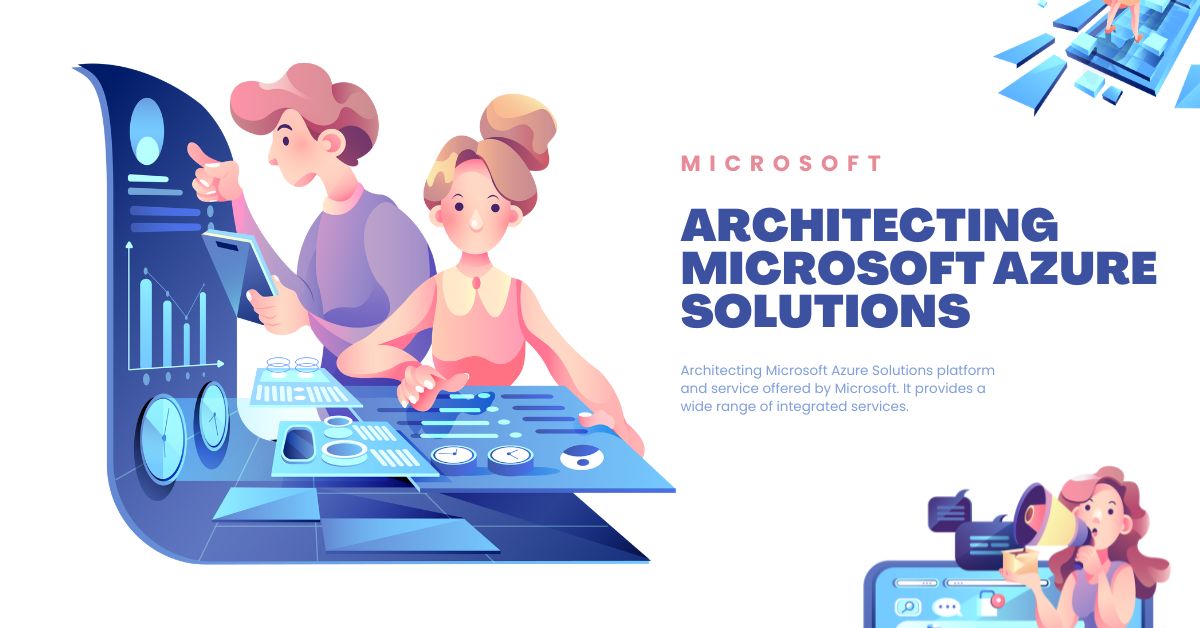Welcome to the world of cloud computing! In today’s fast-paced digital landscape, organizations are constantly seeking innovative solutions to meet their growing technological needs. And that’s where Microsoft Azure comes in. Whether you’re a small business owner or an IT professional working for a large enterprise, understanding how to architect solutions on Azure can be a game-changer for your success.
In this blog post, we’ll dive deep into the realm of Microsoft Azure and explore its various types of solutions. We’ll discuss the pros and cons, highlight the wide range of services it offers, guide you on how to get started with Azure, and even provide some alternatives if you’re looking for other options. So buckle up and get ready to embark on an exciting journey into the world of Architecting Microsoft Azure Solutions!
What is Microsoft Azure?
Microsoft Azure is a cloud computing platform and service offered by Microsoft. It provides a wide range of integrated services, including virtual machines, storage, networking capabilities, and much more. Essentially, it allows individuals and organizations to build, deploy, and manage applications seamlessly on the cloud.
One of the key features that sets Azure apart is its scalability. Whether you’re running a small website or managing large-scale enterprise applications, Azure can scale up or down based on your needs. This flexibility ensures that you only pay for what you use, optimizing cost efficiency.
Another advantage of using Azure is its global presence. With data centers located across the globe in various regions, you can easily deploy your applications closer to your end-users for improved performance and reduced latency.
Azure also offers robust security measures to protect your data and comply with industry regulations. From encryption at rest to continuous monitoring and threat detection systems, Microsoft ensures that your information remains secure in their trusted hands.
Furthermore, Azure provides seamless integration with other Microsoft products such as Office 365 and Dynamics 365. The ability to leverage these interconnected services enhances productivity and streamlines business processes.
Microsoft Azure empowers businesses with the tools they need to innovate rapidly while reducing infrastructure costs. Its vast array of services caters to diverse requirements across industries—making it an ideal choice for architecting scalable solutions in today’s digital era.
The Different Types of Azure Solutions
The world of cloud computing has opened up a myriad of possibilities for businesses, and Microsoft Azure is at the forefront of this technological revolution. With its wide range of solutions, Azure offers something for every organization’s unique needs.
There is Infrastructure as a Service (IaaS), which provides virtual machines, storage, and networking capabilities. This allows businesses to migrate their existing infrastructure to the cloud without having to worry about hardware maintenance or upgrades.
Next up is Platform as a Service (PaaS), where developers can build applications using pre-built tools and services provided by Azure. This solution takes care of all the underlying infrastructure requirements, allowing developers to focus solely on their application logic.
For those looking for more flexibility in managing their applications, there is Container as a Service (CaaS). Using technologies like Docker and Kubernetes, CaaS enables organizations to package their applications into portable containers that can be deployed across different environments seamlessly.
Azure also offers Serverless Computing with its Function as a Service (FaaS) offering. With FaaS, developers can write code snippets that run in response to events or triggers without having to worry about server management. This greatly simplifies development and reduces costs.
Last but not least is Software as a Service (SaaS), where fully functional software applications are delivered over the internet on demand. From email services like Office 365 to customer relationship management platforms like Dynamics 365 – Azure has an extensive SaaS portfolio.
With such diverse solutions available within the Microsoft Azure ecosystem, businesses have unparalleled flexibility in architecting their cloud-based systems tailored specifically for their needs. Whether it’s IaaS for infrastructure migration or PaaS for application development – Azure covers it all! So why wait? Explore the various types of azure solutions today and unlock your organization’s full potential in the cloud!
Pros and Cons of Azure
Azure, Microsoft’s cloud computing platform, offers a range of benefits that make it an attractive choice for businesses. One major advantage is its scalability – Azure allows you to quickly scale up or down your resources based on demand, saving costs and ensuring efficient operations.
Another pro of Azure is its global reach. With data centers located in numerous regions around the world, Azure enables businesses to deploy their applications closer to their end users, resulting in lower latency and improved performance.
Additionally, Azure provides a wide array of services and tools that cater to different business needs. From virtual machines and databases to artificial intelligence capabilities and Internet of Things (IoT) solutions, Azure offers comprehensive services for diverse industries.
On the flip side, one potential downside of using Azure is the learning curve associated with mastering its intricacies. While there are ample resources available for guidance, getting familiar with all the features can be time-consuming for newcomers.
Moreover, like any cloud service provider, there may be concerns about data security when using Azure. However, Microsoft has implemented robust security measures such as encryption at rest and during transmission to address these concerns.
Though – given its flexibility, scalability, global presence,and vast range of services – Microsoft Azure remains one of the leading options for organizations looking to architect reliable and scalable solutions in the cloud space.

What Services does Azure offer?
Azure offers a wide range of services that cater to the diverse needs of businesses and individuals. One of the key offerings is Azure Virtual Machines, which allows users to deploy and run various operating systems on Microsoft’s infrastructure. This service provides scalability and flexibility, enabling users to easily scale up or down based on their requirements.
Another important service provided by Azure is Azure App Service, which enables developers to build, deploy and scale web applications without having to worry about managing the underlying infrastructure. With features such as automatic scaling and continuous deployment, developers can focus on building great applications rather than dealing with server management.
Azure also offers a comprehensive set of data services including Azure SQL Database, Cosmos DB, and Data Lake Storage. These services provide reliable storage options for structured and unstructured data, as well as powerful analytics capabilities for processing big data.
In addition to these core services, Azure provides solutions for artificial intelligence (AI), Internet of Things (IoT), DevOps, networking, security, and more. Whether you need AI-powered chatbots or IoT devices connected in the cloud, Azure has you covered.
Microsoft Azure offers a wide array of services that empower organizations to architect robust cloud solutions tailored to their specific needs. By leveraging these services together with other tools in the Azure ecosystem like Visual Studio and GitHub integration,
users can create scalable and secure applications while enjoying seamless integration with existing Microsoft technologies.
How to Get Started with Azure
Getting started with Microsoft Azure is easier than you may think. Here’s a step-by-step guide to help you kickstart your journey into the world of cloud computing.
First, create an Azure account. You can sign up for a free trial or choose from various paid subscription options based on your needs. Once you have your account set up, familiarize yourself with the Azure portal, where you can manage and monitor your resources.
Next, define your goals and identify which services will best meet your requirements. Whether it’s virtual machines, storage, databases, or AI tools, Azure offers a wide range of services to cater to diverse business needs.
After selecting the appropriate services, start building your first solution in the cloud. Use Azure Resource Manager (ARM) templates for infrastructure as code deployment and leverage pre-built solutions available in the Azure Marketplace to accelerate development time.
To ensure security and compliance, make use of built-in features such as role-based access control (RBAC), network security groups (NSGs), and resource locks. Regularly update and patch your resources to protect against vulnerabilities.
Monitor performance using metrics provided by Azure Monitor and set up alerts for proactive issue detection. Utilize Application Insights for real-time application monitoring and diagnostics.
Continuously optimize costs by rightsizing resources based on usage patterns and implementing auto-scaling where needed. Leverage cost management tools like Budgets and Cost Analysis within the Azure portal to track spending trends over time.
By following these steps, you’ll be well on your way towards architecting effective solutions using Microsoft Azure!
Architecting Microsoft Azure Solutions
While Microsoft Azure is a powerful and popular cloud computing platform, it’s always worth exploring the alternatives to find the best fit for your specific needs. Here are a few noteworthy alternatives to consider:
1. Amazon Web Services (AWS): With its extensive range of services, AWS offers strong competition to Azure. It provides scalable solutions that cater to various industries and has a vast ecosystem of third-party integrations.
2. Google Cloud Platform (GCP): GCP boasts high-performance infrastructure and advanced data analytics capabilities. It also offers seamless integration with other Google products like BigQuery and TensorFlow.
3. IBM Cloud: Known for its enterprise-level offerings, IBM Cloud provides robust security features and supports hybrid cloud deployments. Its wide array of services includes AI-powered Watson services, blockchain technology, and more.
4. Oracle Cloud Infrastructure (OCI): OCI stands out with its focus on reliability, security, performance, and cost-effectiveness. It offers comprehensive solutions including database management systems, autonomous transaction processing capabilities, and integrated AI tools.
5. Alibaba Cloud: Particularly prominent in Asia-Pacific regions but expanding globally at an impressive rate, Alibaba Cloud delivers diverse services such as elastic computing instances, object storage options,and machine learning platforms.
Each alternative comes with its unique set of advantages that may align better with your business requirements than Azure does.
Conclusion
Architecting Microsoft Azure Solutions offers a wide range of benefits for businesses looking to leverage cloud technology. With its vast array of services, scalability, and global reach, Azure provides an ideal platform for building and deploying applications.
Throughout this article, we have explored what Microsoft Azure is and the different types of solutions it offers. We have also discussed the pros and cons of using Azure as well as some alternatives that exist in the market.
When considering whether to choose Azure for your organization’s needs, it is important to evaluate factors such as cost-effectiveness, flexibility, security measures, and integration capabilities with existing systems. Azure provides a robust ecosystem that caters to these requirements while also offering various tools and resources for developers.
Getting started with Microsoft Azure is relatively straightforward. By signing up for an account on the Azure portal, you can begin exploring the platform’s features and experimenting with different services. Additionally, Microsoft provides comprehensive documentation and online training resources to help users navigate their way through architecting solutions on Azure.
While there are alternative cloud platforms available in the market such as AWS or Google Cloud Platform (GCP), each has its own unique set of strengths. Choosing the right solution depends on your specific business needs and goals.
Microsoft Azure presents a powerful option for organizations seeking scalable cloud solutions. Its extensive suite of services coupled with strong support from Microsoft makes it an attractive choice for businesses across industries. By carefully understanding your requirements and leveraging the capabilities offered by Azure architecture patterns, you can build reliable applications that deliver value to both your business operations and customers alike.
Remember though: Architecting successful solutions goes beyond simply selecting a platform – it requires thoughtful planning, design principles implementation,and ongoing optimization efforts throughout your journey with any chosen cloud provider like Microsoft’s very own –Azure! So don’t be afraid to explore all avenues when designing your digital infrastructure; after all,it’s about finding what suits YOUR business best.
